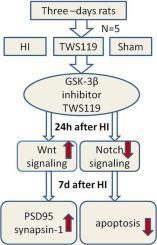Brain Research ( IF 2.7 ) Pub Date : 2021-07-24 , DOI: 10.1016/j.brainres.2021.147588 Limin Gao 1 , Lijun Yang 1 , Hong Cui 1

|
Preterm infant brain injury is a leading cause of morbidity and disability in survivors of preterm infants. Unfortunately, the effective treatment remains absent. Recent evidence suggests that GSK-3β inhibitor TWS119 has a neuroprotective role in adult brain injury by activation of Wnt/β-catenin signaling pathway. However, the role on neonatal brain injury is not yet explored. The study aims to evaluate the effect of TWS119 at 7 d after hypoxic-ischemic brain damage and investigate the mechanism that it regulates Wnt and Notch signaling pathways at 24 h after hypoxic-ischemic brain damage in neonatal rats. Three-day-old rats were randomly divided into 3 groups: sham group, HI group and TWS119 group. The neonatal rats were subjected to left carotid artery ligation followed by 2 h of hypoxia (8.0% O2). A single dose of TWS119 (30 mg/kg) was intraperitoneally injected 20 min prior to hypoxia-ischemia (HI). At 7 d after HI, TWS119 improved the tissue structure, reduced cell apoptosis, up-regulated bcl-2 expression, up-regulated the expression of PSD-95 and Synapsin-1. At 24 h after HI, it activated Wnt/β-catenin signaling pathway by up-regulation of β-catenin protein expression and wnt3a/wnt5a/wnt7a mRNA expression. Simultaneously, it suppressed Notch signaling pathway by down-regulation of Notch1 and HES-1 proteins expression. Our study suggested that TWS119 performed a neuroprotective function at 7 d after hypoxic-ischemic brain damage via a crosstalk with Wnt/β-catenin and Notch signaling pathways at 24 h after hypoxic-ischemic brain damage in neonatal rats.
中文翻译:

GSK-3β抑制剂TWS119通过与新生大鼠Wnt和Notch信号通路的串扰减轻缺氧缺血性脑损伤
早产儿脑损伤是早产儿幸存者发病和残疾的主要原因。不幸的是,仍然没有有效的治疗方法。 最近的证据表明,GSK-3β 抑制剂 TWS119通过激活 Wnt/β-catenin 信号通路在成人脑损伤中具有神经保护作用。然而,尚未探索对新生儿脑损伤的作用。本研究旨在评估TWS119在缺氧缺血性脑损伤后7 d的作用,并探讨其在新生大鼠缺氧缺血性脑损伤后24 h调节Wnt和Notch信号通路的机制。3日龄大鼠随机分为3组:sham组、HI组和TWS119组。新生大鼠结扎左颈动脉,缺氧2 h(8.0% O 2)。在缺氧缺血 (HI) 前 20 分钟腹膜内注射单剂量 TWS119 (30 mg/kg)。HI后7 d,TWS119改善了组织结构,减少了细胞凋亡,上调了bcl-2的表达,上调了PSD-95和Synapsin-1的表达。HI后24 h,通过上调β-catenin蛋白表达和wnt3a/wnt5a/wnt7a mRNA表达,激活Wnt/β-catenin信号通路。同时,它通过下调 Notch1 和 HES-1 蛋白的表达来抑制 Notch 信号通路。我们的研究表明,在新生大鼠缺氧缺血性脑损伤后 24 小时,TWS119 通过与 Wnt/β-catenin 和 Notch 信号通路的串扰在缺氧缺血性脑损伤后 7 天发挥神经保护功能。











































 京公网安备 11010802027423号
京公网安备 11010802027423号